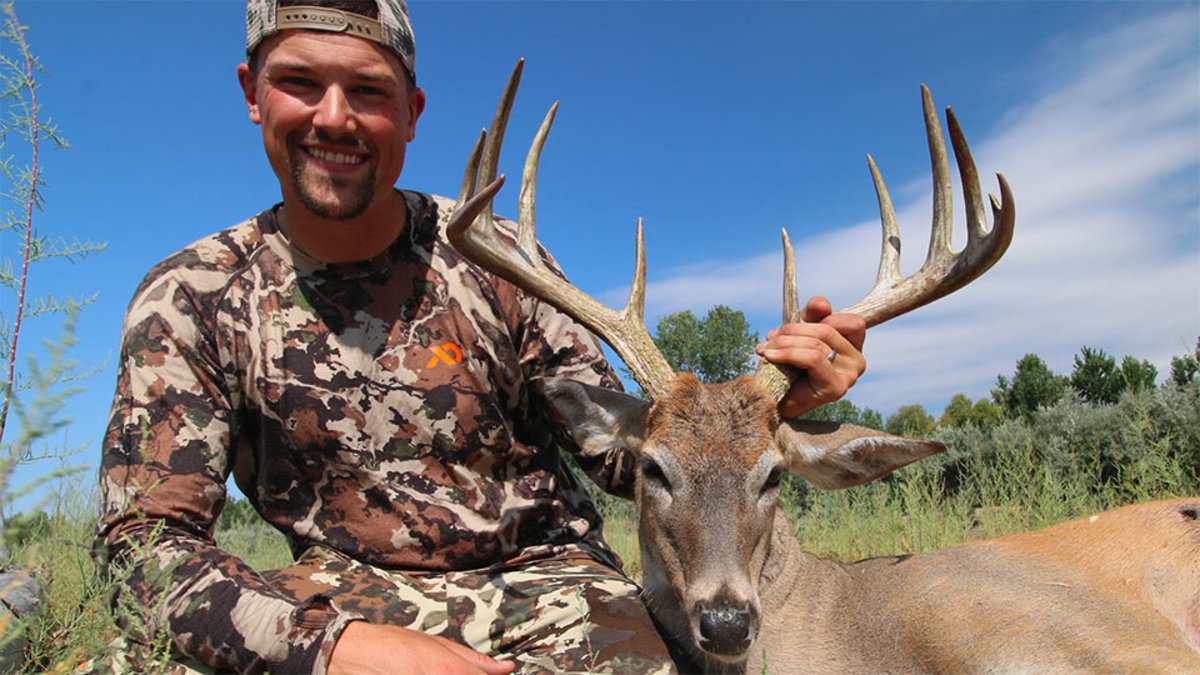
When the average guy or girl thinks about whitetail hunting, it’s likely that visions of tower blinds, green food plots, and piles of corn come to mind. And, of course, whitetail hunting does sometimes seem to look this way – especially if you take what you see on TV as representative of the community as a whole. But it doesn’t have to be this way. Some hunters in whitetail country crave something different. And while it’s usually assumed that a new species such as mule deer, elk, or bear will need to be pursued to scratch that itch, believe it or not, adventure can be had chasing whitetails, too.
I’ve discovered this myself recently since beginning an annual tradition of chasing public land whitetails in Montana, and just recently wrapped up my 2018 trip. This trip serves as a perfect example, I think, of the kind of wild whitetail experience you can have if you search it out.
On this particular excursion, I was hunting river-bottom whitetails in early September. This was an area I had scouted and hunted one year previously, and had specifically chose because of the quality whitetail habitat and its hard-to-get-to-nature, an important element of any whitetail adventure.
My camp was set along a roadside stretch of public land where I could pull in my truck and establish a base of operations. But from there, to get to where I would hunt, I had to hike back about a mile and a half via two different sections of public and four river crossings, which allowed me access to a particularly good looking piece of river-bottom ground that few others would likely head into.
The camping aspect of a hunt like this is a huge part of any adventure for me. The cocoon like warmth of a sleeping bag on a cool night, the soft hiss of a camp stove heating coffee, and a milky-way light show high in the sky above – these small joys make for rich memories. Having the right set-up is important though. I’ve done trips like this with a camper and a tent, and they work fine, but my favorite option now is simply sleeping in the back of my enclosed truck bed. Truck bed camping allows for quick changes in location, easy set-up and the ability to get back into areas that you might not be able to access with a pull-behind camper. After a few years of testing this system, I’ve added a rooftop carrier and built-in truck bed drawer system to increase the storage in my truck, while allowing maximum sleep space in the bed. This system has worked great for me, and with the addition of a folding camp chair, portable camp table and gas stove, it makes for a comfortable camp set-up.
The actual hunting is, of course, a crucial part of any whitetail adventure too – and in most cases I’m looking for a hunt location that requires some serious work to get into. This makes the hunt more challenging – which I enjoy – but also serves the practical purpose of getting you away from other hunters, and likely into more deer. As mentioned already, my trek included a very long hike (for a whitetail guy) and multiple river crossings, but once I reached my destination I was in whitetail paradise. These were deer that were not accustomed to hunters reaching them and it showed in high deer numbers, early movement patterns, and mature buck sightings.
The challenge with this kind of location, other than the distance itself, is lugging in all the required gear – most notably your treestand, bow, and climbing equipment. In past years I’ve used a portable hang-on treestand and climbing sticks, but this year I decided to try something called a tree saddle.
This is a harness that you wear in, and then clip into the tree once you’ve ascended, allowing you to hang from the tree in a seated or standing position. By using a saddle, rather than carrying a stand, I’ve cut my pack weight by about 13 pounds. This has been one of my best new gear additions and one that I see becoming a staple of my future whitetail adventures. Other uniquely important gear for a hunt like this includes having high quality moisture wicking clothing layers (long hikes induce a lot of sweating), a heavy duty backpack for carrying all that gear, and a bow or firearm that’s easily packed as well.
On September 4th, while deep in this location for the third time in a week, a beautiful eleven-point buck waltzed into range and offered a broadside shot. Nearly 24 hours later, after a long night and morning of searching, a miracle recovery, and then a horrendous drag out, I made it back to camp soaked in sweat, speckled with blood, and covered in mud. And I couldn’t be happier.
Being a “whitetail guy” all my life, but also a sucker for adventure, this type of hunt has now become a favorite way for me to combine my outdoor loves. Later this year I’ll be continuing the trend by attempting a backcountry whitetail hunt in Minnesota’s Boundary Waters Canoe Area where we’ll be canoeing deep into the wilderness with seven days worth of camping and deer hunting gear and seeing if we can find a deer or two. And I’m already looking forward to future years and other adventure whitetail hunt ideas such as tracking big woods bucks in Maine or New York, finding swamp deer in the public lands of the South, or backpacking in to chase high mountain whitetails in Idaho.
So if you too crave the adventure of a new setting and challenge, but still harbor a soft place in your heart for whitetails, I’m here to tell you that opportunities abound.




